
|

|
|
Home Site Search Contact Us Subscribe
|
|
INSIGHT: Three Trends to Know in Community Park Landscape Design & Planning A look at the relevant trends that Design Workshop incorporated into the planning and design of the new Branch Park in a mixed-income, mixed-use urban village in Austin, Texas. By Claire Hempel, PLA, AICP, LEED GA October 17, 2019 When it comes to community park landscape design, “problem solver” is the role most of us landscape architects often play. How do you balance space constraints while meeting community needs and stay within the capital budget? Which current community park trends do you pay attention to because they have longevity? How do you create a park that keeps bringing people back? Austin, Texas-based Design Workshop identified important and relevant trends in community park landscape design that we incorporated into the planning and design of the recently opened Mary Elizabeth Branch Park (Branch Park) in the Mueller community, a mixed-income, mixed-use urban village located in Austin, Texas.
When we worked with Catellus Development and the City of Austin to design the 3.5-acre public park, we wanted to accommodate various recreation needs for a multigenerational and multi-use community. The urban park, bordered by single-family housing, an office headquarters, and current and future apartments on all four sides, features a creative children’s playground, dog run, two sand volleyball courts, a rain garden, and an interactive waterscape. There are also shady areas for informal meetings and family picnics, and a large, open lawn for people of all ages and abilities to enjoy. In Branch Park’s case, our design was informed by three nationwide trends we studied:
1. Waterscapes: Waterscapes that are interactive, not just decorative, are a huge trend in park design these days, but they also present numerous challenges. First, the waterscape needs to be carefully and appropriately incorporated into the original design of the park, not simply added as a feature that stands out. This can be hard to accomplish, given how large they often are. Second, there are safety concerns with standing water, so more parks are now looking for creative water features beyond pools. Third, the waterscapes have to appeal to a wide age range to get maximum use, so, when designing them, it’s important to think of access and comfort with water based on age. At Branch Park, water percolates, sprays, and mists out of the stonework, and interactive buttons allow users to activate certain features. In the winter, when the water is shut off, this space becomes another plaza in the park, allowing it to be used year-round. 2. Multifunctional Park Space: When designing Branch Park, we also looked at incorporating a multigenerational and multifunctional aspect, requiring us to design and plan spaces for all ages and abilities. The park also had to be designed for various user groups, including office workers, apartment dwellers, single family occupants, and retail visitors. We balanced the diverse needs of empty nesters seeking outdoor space in which to relax, young adults seeking a space for an evening kickball game, teenagers who want to hang out with friends, young kids who want to play, and employees who want to take a break and get some fresh air. At Branch Park, the design team took all of this into account, incorporating plenty of seating options, shaded areas, viewing gardens, a playground, and generous open spaces conducive to informal games. 3. Fido-friendly Parks: The National Recreation and Park Association’s 2018 Agency Performance Review found that 55% of park and recreation agencies now have established dog parks, and those that don’t are either in the process of building one or in the planning stages. While not everyone is a dog person – it’s important to have a space for our four-legged community members to relax and unwind. The dog run at Branch Park allows neighborhood dogs (and their owners) to interact with one another in a leash-free zone. Pet waste bags, disposal systems, and dog drinking fountains are supplied for users’ convenience. Trees surround the dog run, allowing the space to be more comfortable for owners and dogs throughout the year, even in Texas’s infamously hot summers.
It’s also imperative to design a space that is functional and beautiful – and contributes to the betterment of the environment. This impacts every step of the design and planning process, from sourcing materials and designing native-plant gardens, to hiring labor and maintenance.
Claire Hempel, PLA, AICP, LEED GA, a principal at Austin, Texas-based Design Workshop, oversees a multitude of local, regional, and international projects, including urban and regional parks, urban design, and community and environmental planning. With her background in planning and landscape architecture, Hempel’s professional interests include public engagement, planning on multiple scales, and empowering communities by providing them with the proper tools to achieve environmental, economic, and community goals. |
(click on pictures to enlarge) 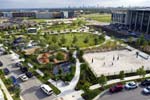 Design Workshop Branch Park is a park for everyone. 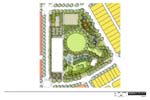 Design Workshop Branch Park site plan 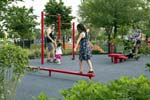 Design Workshop The fitness area has equipment that can be enjoyed by kids and adults alike. 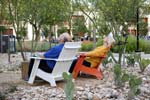 Design Workshop Spots for relaxing in the midst of an urban oasis was an important consideration. 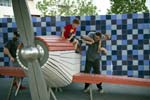 Design Workshop The playground features elements that evoke Branch Park’s previous use as an airport runway.  Design Workshop Space for dogs to run and play is important for city dwellers. 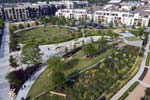 Design Workshop Branch Park is used at all times of the day and year. |
© 2019 ArchNewsNow.com